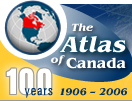| English-French bilingualism rose markedly in Canada
between 1951 and 1996. The number of bilingual Canadians more than
doubled during that period, rising from 1.7 million to 4.8 million,
while their proportion rose from 12% to 17% (Figure 1 below).
 [D] [D]
Click for larger version, 15 KB
Figure 1. Percentage Change in English-French Bilingualism, Canada and Quebec, 1951 to 1996
In 1996, the rate of English-French bilingualism was highest in
Quebec (38%) and New Brunswick (33%). In all other provinces and
territories, bilingualism was considerably lower than the national
rate of 17% (Figure 2 below).
 [D] [D]
Click for larger version, 15 KB
Figure 2. Population with English-French Bilingualism, Provinces and Territories, 1996
However, the rate of bilingualism increased nearly everywhere in the
country in the five-year period before the last census. Between 1991 and
1996, the proportion of the population that was bilingual grew in all
provinces and territories, except Saskatchewan where it remained constant.
The majority of bilingual persons live in Quebec, Ontario, British Columbia
and New Brunswick. In 1996, some 90% of all bilingual persons in
Canada lived in these four provinces. More than half (55%) were
in Quebec, with the largest concentration in the Montreal census
metropolitan area. In Ontario and New Brunswick, it is mainly in
the municipalities bordering Quebec that one finds large proportions
of bilingual persons. The proximity of the two official language
groups is a major reason for the high rate of bilingualism in these
areas. In British Columbia, more than half of bilingual persons
lived in the Vancouver census metropolitan area.
Four of every 10 francophones bilingual1
Across the country, 41%
of francophones were bilingual, almost five times higher than the proportion
of anglophones (9%). The rate of bilingualism of francophones living outside
Quebec was even higher (84%) compared to 7% for anglophones. In contrast,
the proportion of bilingual anglophones living in Quebec (62%) was almost
twice that of francophones in that province (34%).
The rate of bilingualism varied considerably by age group for anglophones
and francophones. The difference reflects the manner in which the two
populations learn a second language.
In the case of Quebec francophones, the job market plays an important
role in learning English as a second language. Hence, the rate of bilingualism
reached a peak (48%) in the age group 20 to 24, ages corresponding to
high labour market participation. The rate stayed high in subsequent age
groups.
For anglophones outside Quebec, school is the main place for learning
French as a second language. Consequently, the highest rate of bilingualism
(16%) was in the age group 15 to 19, the secondary school years. The rate
was lower in older age groups, as French immersion was less popular or
non-existent during their school years.
In the case of persons whose mother tongue was neither English nor French,
their rate of English-French bilingualism remained almost the same between
1991 and 1996. About 47% of allophones who lived in Quebec were bilingual
in 1996, almost nine times higher than the rate among allophones in the
other provinces and territories.
About 69% of Quebec allophones were able to speak French in 1996. This
was a slightly higher proportion than those who were able to speak English
(66%), and represents a significant change from 1971 when 47% of allophones
were able to speak French and 69% were able to speak English. Outside
Quebec, 90% of allophones were able to speak English in 1996, compared
with 5% who were able to speak French.
1Source: The Daily, Statistics
Canada, Tuesday December 2, 1997.
The text for Official Languages is based on the following
publication:
Marmen, Louise and Jean-Pierre Corbeil. Languages in Canada: 1996
Census. New Canadian Perspectives Series. Ottawa: Canadian
Heritage, and Statistics Canada, 1999. Catalogue number: CH3-2-8/1999.
To properly interpret this map, please consult the text Data
and Mapping Notes.
|
